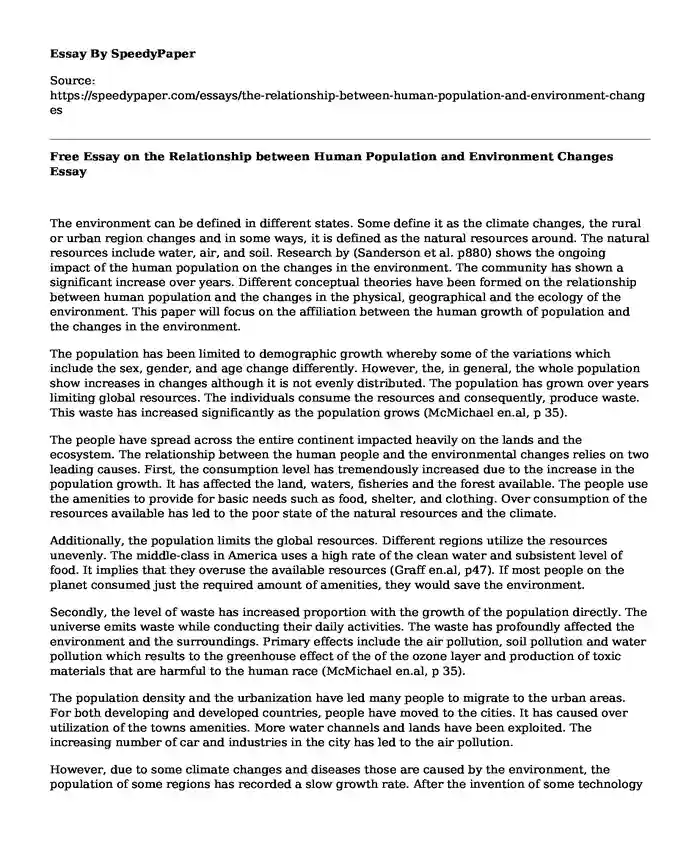
| Type of paper: | Essay |
| Categories: | Environment Population |
| Pages: | 3 |
| Wordcount: | 679 words |
The environment can be defined in different states. Some define it as the climate changes, the rural or urban region changes and in some ways, it is defined as the natural resources around. The natural resources include water, air, and soil. Research by (Sanderson et al. p880) shows the ongoing impact of the human population on the changes in the environment. The community has shown a significant increase over years. Different conceptual theories have been formed on the relationship between human population and the changes in the physical, geographical and the ecology of the environment. This paper will focus on the affiliation between the human growth of population and the changes in the environment.
The population has been limited to demographic growth whereby some of the variations which include the sex, gender, and age change differently. However, the, in general, the whole population show increases in changes although it is not evenly distributed. The population has grown over years limiting global resources. The individuals consume the resources and consequently, produce waste. This waste has increased significantly as the population grows (McMichael en.al, p 35).
The people have spread across the entire continent impacted heavily on the lands and the ecosystem. The relationship between the human people and the environmental changes relies on two leading causes. First, the consumption level has tremendously increased due to the increase in the population growth. It has affected the land, waters, fisheries and the forest available. The people use the amenities to provide for basic needs such as food, shelter, and clothing. Over consumption of the resources available has led to the poor state of the natural resources and the climate.
Additionally, the population limits the global resources. Different regions utilize the resources unevenly. The middle-class in America uses a high rate of the clean water and subsistent level of food. It implies that they overuse the available resources (Graff en.al, p47). If most people on the planet consumed just the required amount of amenities, they would save the environment.
Secondly, the level of waste has increased proportion with the growth of the population directly. The universe emits waste while conducting their daily activities. The waste has profoundly affected the environment and the surroundings. Primary effects include the air pollution, soil pollution and water pollution which results to the greenhouse effect of the of the ozone layer and production of toxic materials that are harmful to the human race (McMichael en.al, p 35).
The population density and the urbanization have led many people to migrate to the urban areas. For both developing and developed countries, people have moved to the cities. It has caused over utilization of the towns amenities. More water channels and lands have been exploited. The increasing number of car and industries in the city has led to the air pollution.
However, due to some climate changes and diseases those are caused by the environment, the population of some regions has recorded a slow growth rate. After the invention of some technology and medicine which helped to improve the nutritions and the living conditions of individuals and thus a reasonable growth rate in the population (McMichael en.al, p 35).
In conclusion, the high population leaves fears that the growth will cause catastrophic effects on the environment. The population increase has led to the poor health of the environment. The community level cannot be controlled, but the consequences on the environment can be (Sanderson et al. p880). The people should concentrate on environmental conservations. Such conservation includes reduction of pollutions and avoiding overexploitation of resources. The humans are advised to emphasize on quality and not quantity.
Work cited
Graff, Gerald, Cathy Birkenstein, and Russel Durst,. They say, I say. WW Norton, 2006.
McMichael, Anthony J., and Rosalie E. Woodruff,. Climate change and human health: Springer Netherlands, 2005.
Sanderson, Eric W., et al. "The Human Footprint and the Last of the Wild The human footprint is a global map of human influence on the land surface, which suggests that human beings are stewards of nature, whether we like it or not." BioScience 52.10 (2002): 891-904.
Cite this page
Free Essay on the Relationship between Human Population and Environment Changes. (2019, Sep 09). Retrieved from https://speedypaper.net/essays/the-relationship-between-human-population-and-environment-changes
Request Removal
If you are the original author of this essay and no longer wish to have it published on the SpeedyPaper website, please click below to request its removal:
- Medicare Essay Sample
- Free Essay on Supply Chain Management. Stock Security
- Research Paper Sample on Irish American Culture
- Essay Example: Gender Difference in Treatment of Major Depression Disorder
- Essay Example on Effects of Social Media on Real Life Communication
- Paper Example. What is a City?
- Free Essay. Own Experiences Concerning Sexual Abuse
Popular categories




